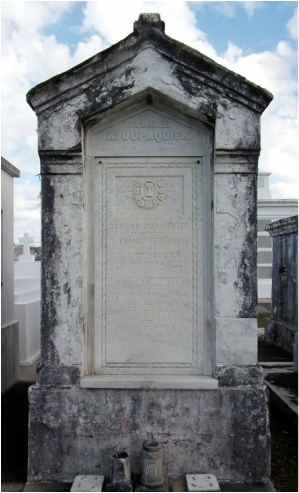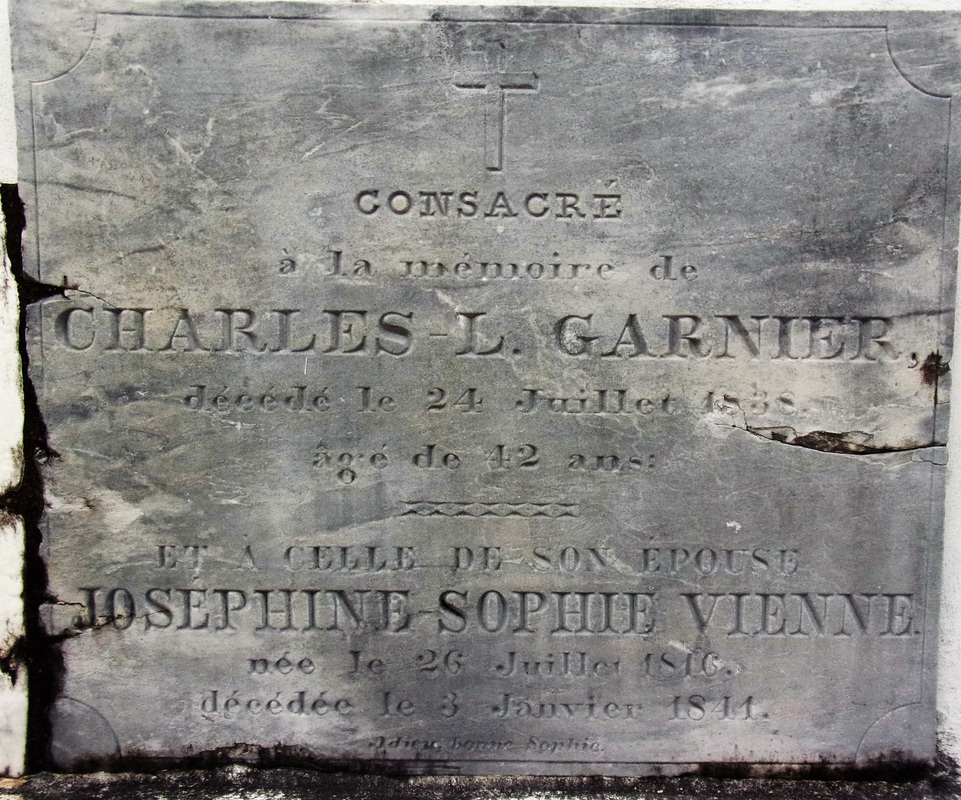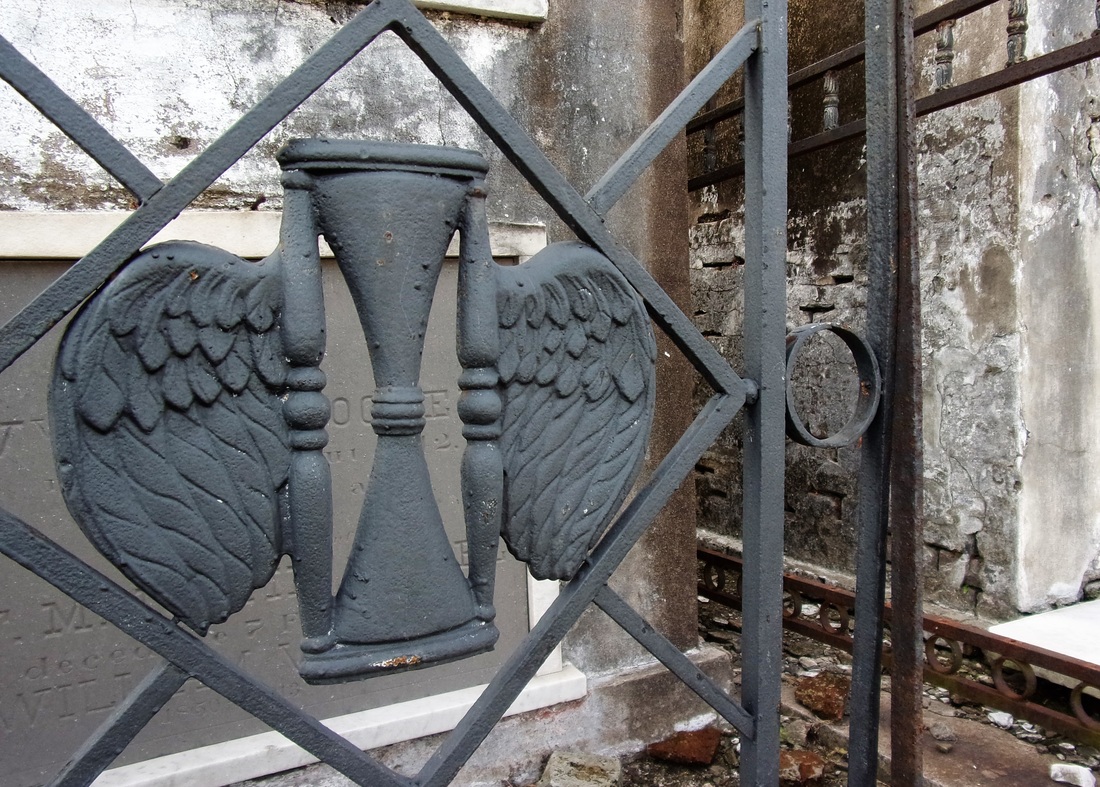|
At the end of the main aisle in Square 1 of St. Louis No. 2 is a simple tomb with a low-pitched gable roof. Coated in modern cement and latex paint, it is difficult to determine much about its original appearance. Perhaps it was once coated in brightly-colored stucco, or its roof tiled in slate or terra cotta. Ironwork may once have enclosed its simple design. Without the fortunate discovery of an historic photograph, which is extremely rare, the elegant past of this tomb may never be known. But the de Armas tomb offers a hint to the scrutinizing eye. Its marble closure tablet is embellished with an ornate relief carving depicting a winged hourglass encircled with a floral wreath. The hourglass is surrounded by a snake eating its tail – the ouroboros – a symbol of immortality. Among the few depictions of the winged hourglass in St. Louis Cemetery No. 2, this carving is by far the most detailed. Such a carving is indicative of a level of style and craftsmanship long faded from New Orleans cemeteries. At one time it was not alone in its ornamental beauty, but instead belonged to a rich landscape of beaded wreaths, draped urns, and weeping angels. Even today, the de Armas tomb is not alone in one regard. Nearly three miles away, St. Louis Cemetery No. 2’s younger sister, St. Louis No. 3, stretches along the edge of Bayou St. John in long aisles. Amidst its large lots and photogenic tombs is the tomb of the Depaquier family. Uncompromised by modern repairs, the faded stucco walls bely that the tomb was once limewashed a dark rose color. The pitch of its roof is reminiscent of the de Armas tomb. The closure tablet of Dupaquier tomb is bordered with a carved braided rope. Atop its simply-lettered epitaph is a winged hourglass nearly identical to that found on the de Armas tomb in St. Louis Cemetery No. 2. Studies of cemetery craftsmanship in New Orleans have shown that few motifs, materials, or methods in cemetery stonecarving are the result of happenstance. Who carved these tablets? What do they symbolize? And why did the Dupaquier and de Armas families end up owning identical tablets? The de Armas and Dupaquier Families The two tombs are the burial places of the patriarchs of their respective families. In St. Louis No. 2, Michel Theodore de Armas (sometimes listed in documents as Michael or Miguel), was a notary and lawyer who was born in New Orleans in 1783 and died in 1823.[1] In St. Louis No. 3, Claude Dupaquier was born in France in 1806, arrived in New Orleans in the 1840s, and died in 1856.[2] Between 1823 and 1856, life expectancy was around 37 years, so that these men died at age 40 and 50 (respectively) is unremarkable. Both de Armas and Dupaquier had children that became important members of New Orleans’ business and social circles after the Civil War. Dr. Auguste Dupaquier, who is buried with his parents, was described as having a “gentle, loving, and kindly temperament, mixed with firmness and rare energy, and he secured the affections of all whom he approached.[3]” Dr. Dupaquier had no discernable interaction with the children of de Armas, and it is unlikely that the families had enough relation to construct matching tombs knowingly. One significant similarity between the Michel de Armas and Claude Dupaqueir was their preference for the French language. Both tablets are carved in French.
In nineteenth century New Orleans, a person’s linguistic and cultural identity often determined who they chose to carve their final epitaph or build their eternal resting place. For de Armas, or his widow, Gertrude St. Cyr Debreuil, it would have been a given that they chose Paul Hippolyte Monsseaux. New Orleans cemeteries are populated with the small, often overlooked signatures of local stonecutters. Often these signatures wear away, and craftsmen often neglected to sign their work at all. Many stonecutters began their careers working for other more established cutters, signing the name of their master instead of that of the apprentice. These realities complicate the study of cemetery craftwork. In the case of the de Armas closure tablet, a small, clean-lettered signature is present at its bottom right-hand corner – MONSSEAUX. The Depaquier tomb retains no signature at all. Paul Hippolyte Monsseaux Like Claude Depaquier, Paul Hippolyte Monsseaux (1809-1874) was a French native who arrived in New Orleans as an adult.[4] Present in New Orleans by 1842, Monsseaux is best known as the stonecutter who built many tombs designed by architect J.N.B. De Pouilly. These included many famous tombs in St. Louis Cemetery No. 2. Monsseaux often worked with other stonecutters in either a master/apprentice role or as business partners. In addition to his work for J.N.B. de Pouilly, his signature is often found beside other cutters like Tronchard and Kursheedt & Bienvenu. Through his entire career, Monsseaux held the same marble yard on St. Louis Street at the corner of Robertson Street – directly beside St. Louis Cemetery No. 2 and New Basin Canal. Through his career, Monsseaux also sold marble to fellow stonecutters; he partnered with others to secure equipment and technology that advanced the trade. Most notably, he owned a steam marble works for some time in the 1870s, the rights to which he lent to other cutters Stroud and Richards.[5] Monsseaux’s accomplishments were many, but his clientele was rather distinct. Most of Monsseaux’s signed tablets are carved in French. In this manner, Monsseaux is a French counterpart for German-speaking stonecutters of the time who served a distinctly German clientele. There are always exceptions – Monsseaux built the DePouilly-designed Iberian Society tomb in St. Louis Cemetery No. 2. Yet the majority of his work served French-speaking clients who belonged to the upper echelons of New Orleans society. Stylistic Inspirations and Symbolism French speaking upper-class New Orleaneans in the 1830s were enthralled with the style and beauty of tombs found in Paris’ Pere Lachaise Cemetery at the time, and Paul Hippolyte Monsseaux gladly catered to that demand. Sarcophagus-style tombs with corner acroteria and inverted torches appeared in St. Louis No. 2 during this time. These tastes adapted through the 1850s and into the first years of St. Louis Cemetery No. 3. Greek Revival temples and Egyptian Revival tombs rose in the squares of the both cemeteries, mimicking the aisles of the great French burial ground. Often, it was Monsseaux who provided his clients with these romantic sepulchers. Pere Lachaise Cemetery is populated with hundreds of winged hourglasses. In fact, the first image to greet the visitor at the cemetery gate is a pair of such hourglasses. This is also the case at Montparnasse Cemetery, also in Paris. The history of the winged hourglass as a funerary symbol appears to split along linguistic and cultural lines in the United States. In the English-speaking Northeast, it is contemporary with the skull-and-crossbones and death’s head, symbolizing the fleetingness of time. In this context, the winged hourglass was contemporary to the 18th century and faded from popularity by the 1830s. French-speaking New Orleans funerary culture developed more closely to that of Paris than its American cousins, however. The winged hourglass is seldom seen in tombs constructed prior to 1820. It does, however, appear to grow in popularity from 1820 through the 1850s, when the de Armas and Dupaquier tombs were constructed. This inspiration was drawn directly from the Parisian cemeteries. And New Orleans was not alone in this inspiration. Not to be outdone as a European city in the New World, Buenos Aires’ Recoleta Cemetery, founded in 1822, hums with the flutter of winged hourglasses. The de Armas and Dupaquier families may never have known each other, but they are together twin scions of a lost cemetery landscape. Opulent with their floral wreaths and outspread wings, their hourglass tablets were likely carved by Monsseaux himself or an apprentice. It is possible, even, that the Dupaquier tablet was a replica of de Armas’, carved by a student still learning his trade. Or, perhaps, both designs were borrowed from a pattern book imported from Paris. In any case, they endure as silent reminders of the importance of each tomb in the larger landscape of our historic cemeteries. [1] Florence M. Jumonville, Ph.D., ‘Formerly the Property of a Lawyer’: Books that Shaped Louisiana Law. New Orleans: University of New Orleans Library Facility Publications, 2009, 7.
[2] Orleans Death Indices 1804-1876. Vol. 17, 312. [3] “Death of Dr. Dupaquier,” New Orleans Daily Democrat, April 8, 1879, p. 8. [4] Charles LeJ. Mackie, “Paul Hippolyte Monsseaux: Marble Dealer,” printed in SOCGram, Fall 1984, 14-16. [5] Daily Picayune, May 18, 1871, 3.
8 Comments
|
About the Author:Emily Ford owns and operates Oak and Laurel Cemetery Preservation, LLC. Archives
November 2019
Categories
All
|
- About
-
Restoration
- Services
-
Portfolio
>
- Turning Angel Statue, Natchez, MS
- Ledger Monument, Baton Rouge, LA
- Pyramid Statuary, New Orleans, LA
- Bronze and Granite Monument, Carville, LA
- Box Tomb, New Orleans, LA
- Vernacular Concrete Monument, Pensacola, FL
- 1830s Family Tomb, Covington, LA
- 1850s Family Tomb, New Orleans, LA
- 1880s Family Tomb, New Orleans, LA
- Headstone and Monument Restorations, Pensacola, FL
- Society Tomb, New Orleans, LA
- Education
- Blog
- Contact
|
Oak and Laurel Cemetery Preservation, LLC is a preservation contractor in New Orleans, Louisiana, specializing in historic cemeteries, stone conservation, educational workshops and lectures. Oak and Laurel serves the region of the Southeastern US.
|
QUICK LINKS |
CONNECT |
Proudly powered by Weebly












